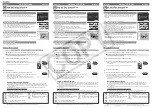
11
On the Schedule page, select whether the schedule is enabled, and specify the schedule details,
then click
Next
.
12
Review the summary, then click
Save
.
Update tasks
Once an update package has been checked in to the master repository and replicated to the
distributed repositories, the agents on the managed systems still need to know when to go to the
distributed repositories for updates. If you are using global updating, this is not necessary.
You can create and configure update client tasks to control when and how managed systems receive
update packages. If you are not using global updating, creating these tasks are the only way you can
control client updating with the ePolicy Orchestrator software.
If you are using global updating, this task is not necessary, although you can create a daily task for
redundancy.
Considerations when creating update client tasks
Consider the following when scheduling client update tasks:
• Create a daily Update client task that the highest level of the System Tree that is inherited by all
systems. If your organization is large, you can use randomization intervals to mitigate the
bandwidth impact. Also, for large networks with offices in different time zones, help balance
network load by running the task at the local system time on the managed system, rather than at
the same time for all systems.
• Schedule the task at least an hour after the scheduled replication task, if you are using scheduled
replication tasks.
• Run update tasks for DAT and engine files at least once a day. Managed systems might be logged
off from the network and miss the scheduled task. Running the task frequently ensures these
systems receive the update.
• Maximize bandwidth efficiency and create several scheduled client update tasks that update
separate components and run at different times. For example, you can create one task to update
only DAT files, then create another to update both DAT and engine files weekly or monthly (engine
packages are released less frequently).
• Create and schedule additional tasks to update products that do not use the agent for Windows.
• Create a task to update your main workstation applications, such as VirusScan Enterprise, to
ensure they all receive the update files. Schedule it to run daily or several times a day.
Updating managed systems regularly with a scheduled update task
Use this task to create and configure update tasks. If you are not using global updating, McAfee
recommends using a daily Update client task to ensure systems are up-to-date with the latest DAT
and engine files.
Task
For option definitions, click
?
in the interface.
1
Click
Menu
|
Policy
|
Client Task Catalog
, select
McAfee Agent
|
Product Update
as Client Task Types, then click
Actions
|
New Task
. The New Task dialog box appears.
2
Ensure that
Product Update
is selected, then click
OK
.
3
Type a name for the task you are creating and add any notes.
Using tasks to manage products and systems
Client tasks and what they do
16
McAfee
®
ePolicy Orchestrator
®
4.6.0 Software Product Guide
203
Summary of Contents for EPOCDE-AA-BA - ePolicy Orchestrator - PC
Page 1: ...Product Guide McAfee ePolicy Orchestrator 4 6 0 Software...
Page 14: ......
Page 20: ......
Page 24: ......
Page 26: ......
Page 42: ......
Page 46: ......
Page 76: ......
Page 100: ......
Page 108: ......
Page 120: ......
Page 158: ......
Page 162: ......
Page 210: ......
Page 228: ......
Page 238: ......
Page 264: ......
Page 288: ......
Page 310: ......
Page 314: ......
Page 328: ...00...
















































